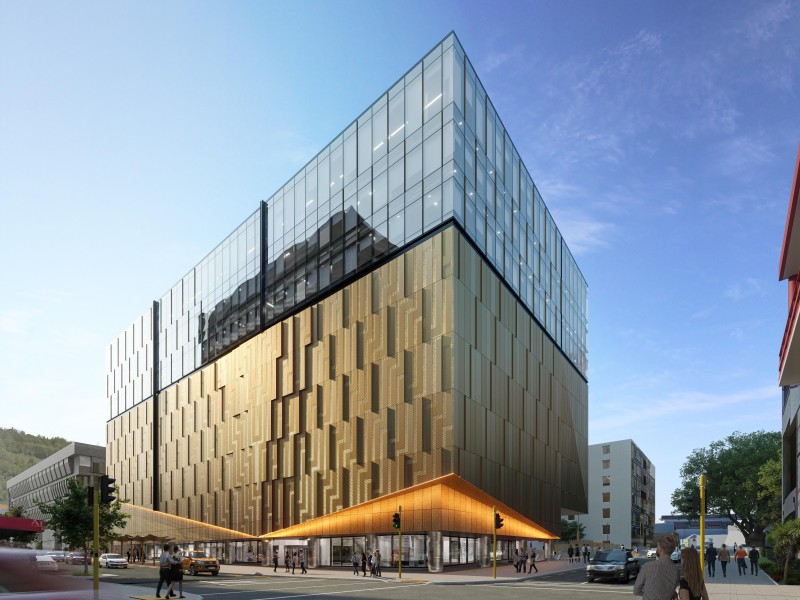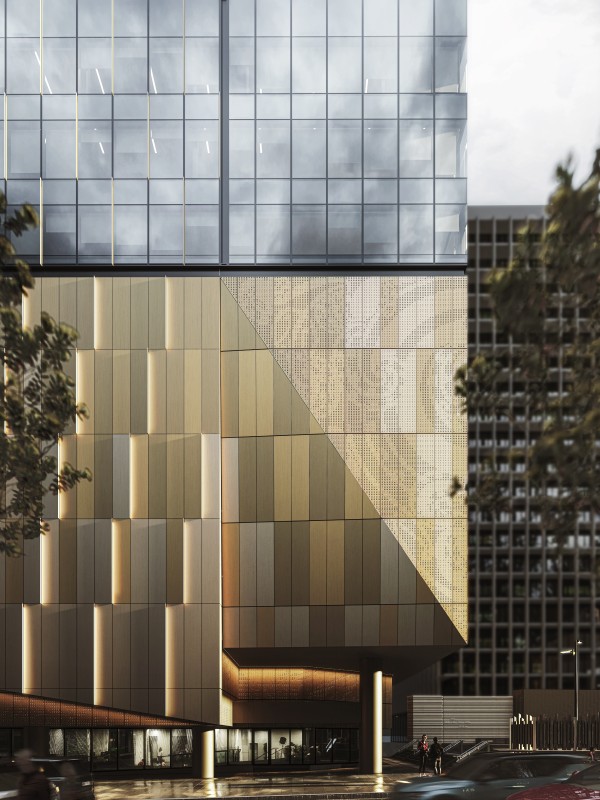Sustainability is a central theme in Aotearoa’s new future focused Archives building in Wellington.
One of the most significant public buildings of our time, this resilient, purpose-built facility has gained a 5 Green Star Design rating recognising its highly sustainable form.
Essentials
What: a new 10 level facility to house, preserve and protect the memory of government and our taonga, holdings and collections.
Specifics: there are 5 floors of high performing repository space for archival holdings plus laboratory spaces and highly specialised digitisation and conservation facilities servicing three major cultural institutions - Archives New Zealand Te Rua Mahara o te Kāwanatanga; National Library of New Zealand Te Puna Mātauranga Aotearoa; Ngā Taonga Sound & Vision
Building details: the new 20,000 square metre Archives building is connected to the adjacent National Library via a two-level link bridge allowing easy access and collaboration between the two buildings; the interplay creates a striking new heritage campus - a landscaped courtyard fostering respite and health in the inner-city Thorndon precinct
Configuration: the ground floor and Level 1 of the new Archives building offer direct access to He Tohu (a permanent exhibition of three iconic constitutional documents) and Reading Room services in the National Library; Level 8 comprises offices for Archives staff;Basement and Levels 6 and 7 feature specialised technical work spaces for digitsation and conservation; the remaining floors feature a range of specialised storage environments for holdings.
Projected daily occupancy: 150 staff plus visitors
Address: 2-12 Aitken Street, Wellington
Project Snapshot
Owner: PSPIB/CPPIB Waiheke Inc.
Developer: Dexus
Long-term tenant : Te Tari Taiwhenua Department of Internal Affairs (DIA) - 25 year lease
Architect: Warren and Mahoney
Architectural partnership: Taranaki Whānui ki Te Upoko o Te Ika representatives and design agency Tihei have worked alongside Warren and Mahoney to co-design the building with a te ao Māori world view, connecting it to the whenua it sits on and acknowledging the people that lived here before
Main contractor: LT McGuinness Limited
Service engineer: Norman Disney & Young
Sustainability consultant: Norman Disney & Young
GSAP: Hayley Koerbin, NDY
Project timeline: Te Huringa o Papatūānuku (the turning of the earth to mark the start of work on site) February 2022; estimated construction completion 2025; opening 2026
Project certification: 5 Green Star - Design Review rating (April 2023)

With the existing Te Tari Taiwhenua Department of Internal Affairs’ Archives headquarters in nearby Mulgrave Street at full capacity and at the end of its economic life - a solution had to be found.
That solution is Aotearoa’s most modern national archives hub to date, and a stimulating example of high-tech, low-energy, sustainable architecture.
Previously the site of Defence House before it was demolished due to structural damage in the 2016 Kaikoura earthquake, the new building has had sustainable design and operation as a key principle from its inception.
“A 5 Green Star rating for the specialised design of this important building was set as a minimum target by Dexus prior to this becoming a government requirement,” says Te Tari Taiwhenua DIA, Tāhuhu Te Ara Tahi director, Rob Stevens.
All new large-scale New Zealand government infrastructure investments must now meet a minimum 5 Green Star accreditation
“A steering group of our senior leaders has been established to monitor and reduce our carbon emissions, instilling behavioural changes from the top. Te Tari is also investing in a progressive electrification of its corporate vehicles fleet, targeting a 15% reduction in travel emissions for 2023/24,” says James Dunn, Department of Internal Affairs Director of Property Workplace Services.
DIA’s push to reduce its environmental impact is reflected in the context of its new 5 Green Star Design rated Archives building.
Building developer Dexus says its purpose is ‘to create spaces where people thrive’.
“This drives us to design and build spaces using the industry’s best practice to enable occupants to feel comfortable and energized to enable them to thrive,” Dexus Development Manager, – Phill Stanley says.
“Using the Green Star Rating Tool allows us to translate and demonstrate to our customers and investors that we are committed to delivering high-quality assets with a focus across sustainability for the occupants, the community, and the environment.”
Viewed as bringing transformational change to archival facilities in Aotearoa, the new building will share its facilities with the adjacent National Library and Ngā Taonga (currently housed within the National Library) across collections and holdings access, secure loading, receiving and quarantine areas, AV suites, conservation laboratories, digitisation spaces, seminar and meeting facilities, and staff end-of-trip facilities, including bike parks.
Sustainable highlights of the building include:
- a climate adaptation plan (following a workshop of future climate scenarios and key risks with the design and facilities teams to build resilience into the project’s design)
- the building’s environmental systems and essential services will be capable of operating for three weeks after a major event without physical intervention, with power resilience provided by a BMS system which can remotely instruct the shutdown of various switchboards
- high performance building envelope combining thermal performance ‘far exceeding’ building code requirements, with proposed air tightness testing at end of construction to verify performance. The innovative façade ensures a highly insulated, airtight repository where outside weather conditions do not impact the internal environment. The façade minimises the effort of the building’s mechanical plant to correct conditions with low operational energy requirements
- fully addressable lighting controls with dimmed and presentation pre-set scenes via local lighting control panels
- a major focus on material selections - low VOC materials with recycled content throughout.
- heating and domestic hot water is provided by electric heat pumps, with no gas consumption on site. The building is ultimately fossil fuel free with the exception of emergency power
- A ‘Digital Twin’ application for facilities management allows asset management to ensure resilience of the operating the building mechanical and electrical systems to ensure they are maintained efficiently
While showcasing ‘excellence’ in sustainability, the building also features ground-breaking resilience.
“It is designed to be the most resilient structure in Aotearoa and its base isolators are some of the largest in the world - designed to withstand a 1 in 1800 year earthquake, and allowing the building to move up to 1300mm in any direction,” says Rob.
“The high resilience design is about keeping our nation’s archival holdings and taonga safely housed for future generations while keeping our kaimahi [staff] and visitors safe as well.”
DIA says the building’s 5 Green Star Design rating is confirmation it is climate friendly and meets the standard for a carbon neutral public sector.
“Te Tari Taiwhenua is committed to reducing carbon emissions and being an example to the industry. We are really pleased our mahi and contribution towards sustainable design and construction has been recognised by the NZGBC,” says Te Tari Taiwhenua DIA director of property workplace services, James Dunn.
“Being a 5 Green Star rated building ensures not only the construction but also the occupation of the building has a limited impact on the environment through efficient use of energy, lighting, temperature control and water consumption. All of which contributes to a more efficient and better run building with lower long-term environmental and financial costs while providing a healthy work environment.”
Meanwhile Warren & Mahoney studio head of design, principal, Rodney Sampson says attaining 5 Green Stars for the project is a major achievement.
“The incredibly technical nature of a facility like this can absorb the project team’s full attention and it would have been easy to waiver on this as an aspiration. However, the commitment from Dexus, DIA and the project team has been steadfast.”
“Projects like this are few and far between and we feel privileged to be part of the project team/guardians of this once-in-a-generation legacy project,” says Rodney.
He says two of the core principles of the project have been cultural design integration and sustainability, with mana whenua and the building’s relationship to the land paramount right from the outset.
“These two principles are inseparable. For example, significant elements such as the façade provide a dual role, firstly as a major opportunity for the expression of mana whenua while at the same time delivering a highly innovative resilient façade with an articulated rain screen providing a ‘heat shield’ designed to meet the highest performance standards and deliver incredibly low operational energy requirements.”
Rangi Kipa, Co-design lead on behalf of Mana whenua/Taranaki whanui facilitated the design team to explore how their collective practise could be influenced by placemaking, by drawing meaning and by being shaped by the social and political history of the site of the build.
“We are interested in the both the sustainability of the building infrastructure and responsibly caring for the heritage documentary assets held in trust for the nation. But we are also concerned in the sustainability of native peoples in their own lands. The integration of mana whenua in the spatial and architectural expression of national cultural institutions means that the it’s a sign that Aotearoa is maturing, we are not as fragile as we once were, and that we can accommodate professional conversations and vocational praxis that lead to social justice and aspirational futures of mutual flourishing.”
“The project has involved a deep dive into the history of the site and the whenua. There is so much to learn from te ao Māori concepts and the connected health and wellbeing of the whenua, the environment and our people,” says Rodney.

NDY Global Sustainability Director, Hayley Koerbin is the project’s GSAP. “The facility is demonstrating sustainable practices through its focus on improved climate resilience, reducing operational carbon and improving the health and wellbeing of occupants.”
Hayley says the building’s sustainable features will deliver high quality air indoors while the control of temperature and humidity will provide comfortable conditions “not only in the archival spaces but also in the receiving and conservation spaces – ultimately supporting better health, wellbeing and productivity.”
She says the building performance specification sets out a targeted energy use of less than 150 kWh/m2/yr. Predictive dynamic thermal modelling show the project is expected to perform better than this target.
With airtightness a key consideration, the new building has been designed and constructed to minimise the uncontrolled movement of air through the walls, roof, floor and joinery.
She says while common in Europe and mandatory for Green Star projects in Australia, designing for and verifying airtightness is not usual practice in New Zealand.
“We typically only hear of airtightness testing on small residential projects. This building will be one of the largest projects in Aotearoa to undertake airtightness testing.”
Main contractor LT McGuinness says the new Archives building is one of the largest and most technical projects it has undertaken to date.
The company believes the highly detailed and comprehensive planning of the project’s design team has been key.
LT McGuinness project manager, Ben Whaanga says the project is fully incorporated in the 3D BIM data environment “which means we are able to review and minimise any potential re-work - reducing as much waste as possible.”
“We’re promoting recycling and reusing materials where possible and we hold regular toolbox talks with our wider team to ensure the sustainability message is passed on. The input from our sustainability manager Ben Cannon has been a great resource for our company.”
Te Tari Taiwhenua Department of Internal Affairs says the new Archives building will be given a new identity and name in consultation with Taranaki Whānui ki Te Upoko o Te Ika.
Green features include:
|
Technical features include:
Innovations:
|
